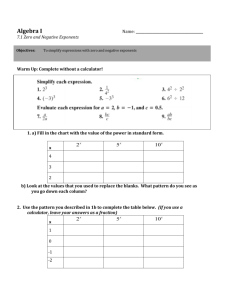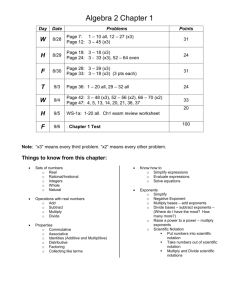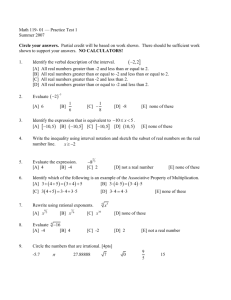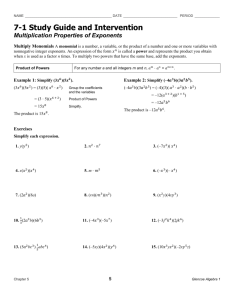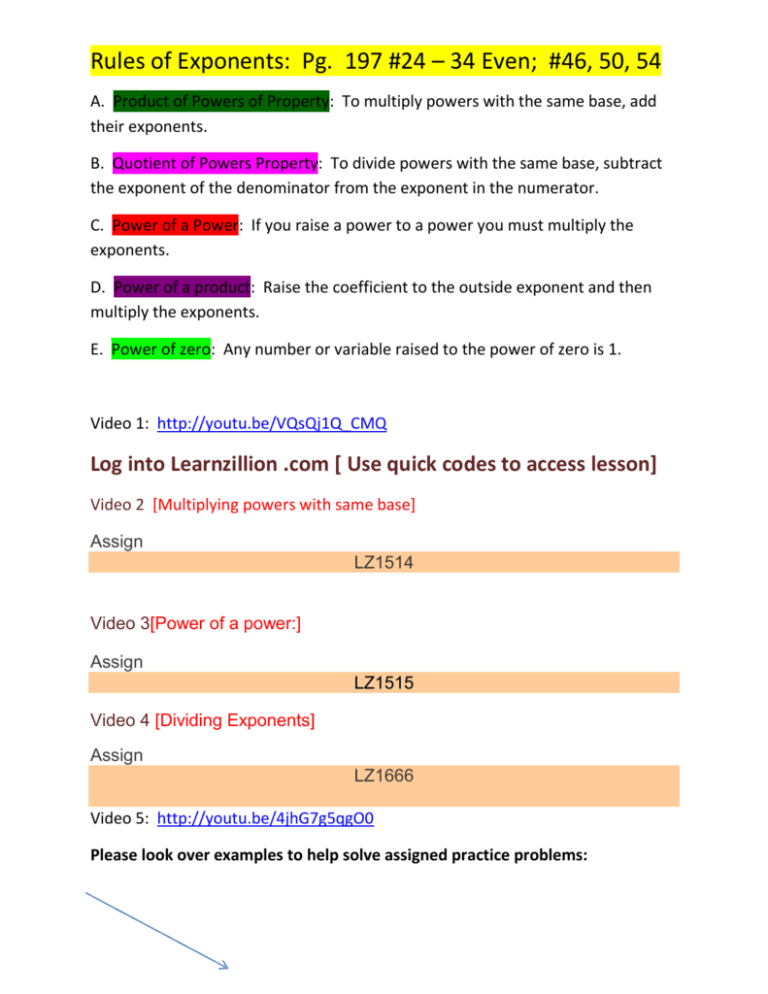
Rules of Exponents: Pg. 197 #24 – 34 Even; #46, 50, 54
A. Product of Powers of Property: To multiply powers with the same base, add
their exponents.
B. Quotient of Powers Property: To divide powers with the same base, subtract
the exponent of the denominator from the exponent in the numerator.
C. Power of a Power: If you raise a power to a power you must multiply the
exponents.
D. Power of a product: Raise the coefficient to the outside exponent and then
multiply the exponents.
E. Power of zero: Any number or variable raised to the power of zero is 1.
Video 1: http://youtu.be/VQsQj1Q_CMQ
Log into Learnzillion .com [ Use quick codes to access lesson]
Video 2 [Multiplying powers with same base]
Assign
LZ1514
Video 3[Power of a power:]
Assign
LZ1515
Video 4 [Dividing Exponents]
Assign
LZ1666
Video 5: http://youtu.be/4jhG7g5qgO0
Please look over examples to help solve assigned practice problems:
Rules of Exponents: Pg. 197 #24 – 34 Even; #46, 50, 54
Simplifying Expressions with Exponents (page 1 of 3)
To simplify with exponents, don't feel like you have to work only from the rules for exponents. It is often
simpler to work directly from the definition and meaning of exponents. For instance:
Simplify x6
× x5
The rules tell me to add the exponents. But I when I started algebra, I had trouble keeping the
rules straight, so I just thought about what exponents mean. The " x6 " means "six copies
of xmultiplied together", and the " x5 " means "five copies of x multiplied together". So if I multiply
those two expressions together, I will get eleven copies of x multiplied together. That is:
x6 × x5 = (x6)(x5)
= (xxxxxx)(xxxxx)
(6 times, and then 5 times)
= xxxxxxxxxxx
(11 times)
= x11
Thus:
x6 × x5 = x11
Simplify the following expression:
The exponent rules tell me to subtract the exponents. But let's suppose that I've forgotten the
rules again. The " 68 " means I have eight copies of 6 on top; the " 65 " means I have five copies
of 6 underneath.
How many extra 6's do I have, and where are they? I have three extra 6's, and they're on top.
Then:
Simplify the following expression:
Rules of Exponents: Pg. 197 #24 – 34 Even; #46, 50, 54
How many extra copies of t do I have, and where are they? I have two extra copies, on top:
Simplify the following expression:
How many extra copies of
Copyright © Elizabeth Stapel 2004-2011 All Rights Reserved
5 do I have, and where are they? I have six extra copies, underneath:
Note: If you apply the subtraction rule, you'll end up with 53–9 = 5–6, which is mathematically correct, but
is almost certainly not the answer they're looking for. Whether or not you've been taught about negative
exponents, when they say "simplify", they mean "simplify the expression so it doesn't have any negative
or zero powers". Some students will try to get around this minus-sign problem by arbitrarily switching the
sign to magically get " 56 " on top (rather than below a "1"), but this is incorrect.
Simplify the following expression:
Don't forget that the "5" and the "3" are just numbers. Since 3 doesn't go evenly into 5, I can't
cancel the numbers. Don't try to subtract the numbers, because the 5 and the 3 in the
fraction " 5/3 " are not at all the same as the 5 and the 3 in rational expression " x5 / x3 ". The
5
/3 stays as it is.
For the variables, I have two extra copies of
x on top, so the answer is:
Rules of Exponents: Pg. 197 #24 – 34 Even; #46, 50, 54
Either of the purple highlighted answers should be acceptable: the only difference is in the formatting;
they mean the same thing.
Simplify (–46x2y3z)0
ADVERTISEMENT
This is simple enough: anything to the
zero power is just 1.
(–46x2y3z)0 = 1
Simplify –(46x2y3z)0
The parentheses still simplifies to 1, but
this time the "minus" is out front, out from
under the power, so the exponent doesn't
touch it. So the answer is:
–(46x2y3z)0 = –1
Simplify the following expression:
I can cancel off the common factor of
5 in the number part of the fraction:
Now I need to look at each of the variables. How many extra of each do I have, and where are
they? I have two extra a's on top. I have one extra b underneath. And I have the same number
ofc's top and bottom, so they cancel off entirely. This gives me:

